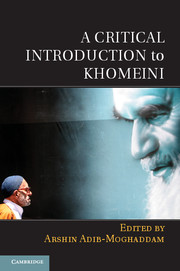Book contents
- Frontmatter
- Contents
- List of Map and Figures
- About the Authors
- Acknowledgments
- Glossary
- Timeline: The Life of Ayatollah Ruhollah Khomeini (1902–1989)
- Introduction Ayatollah Ruhollah Khomeini: A Clerical Revolutionary?
- 1 Khomeini and the “White Revolution”
- 2 The Rise of Khomeinism
- 3 Wilayat al-Faqih and the Meaning of Islamic Government
- 4 Ayatollah Khomeini’s Rule of the Guardian Jurist
- 5 Khatt-e Imam
- 6 Khomeini and the West
- 7 Gendered Khomeini
- 8 Hidden Khomeini
- 9 The Divine, the People, and the Faqih
- 10 Khomeini’s Legacy on Women’s Rights and Roles in the Islamic Republic of Iran
- 11 To Rule, or Not to Rule? An Alternative Look at the Political Life of Ayatollah Khomeini between 1960 and 1980
- 12 Khomeini and the Decolonization of the Political
- 13 Contentious Legacies of the Ayatollah
- Further Reading
- Index
- References
8 - Hidden Khomeini
Mysticism and Poetry
Published online by Cambridge University Press: 05 June 2014
- Frontmatter
- Contents
- List of Map and Figures
- About the Authors
- Acknowledgments
- Glossary
- Timeline: The Life of Ayatollah Ruhollah Khomeini (1902–1989)
- Introduction Ayatollah Ruhollah Khomeini: A Clerical Revolutionary?
- 1 Khomeini and the “White Revolution”
- 2 The Rise of Khomeinism
- 3 Wilayat al-Faqih and the Meaning of Islamic Government
- 4 Ayatollah Khomeini’s Rule of the Guardian Jurist
- 5 Khatt-e Imam
- 6 Khomeini and the West
- 7 Gendered Khomeini
- 8 Hidden Khomeini
- 9 The Divine, the People, and the Faqih
- 10 Khomeini’s Legacy on Women’s Rights and Roles in the Islamic Republic of Iran
- 11 To Rule, or Not to Rule? An Alternative Look at the Political Life of Ayatollah Khomeini between 1960 and 1980
- 12 Khomeini and the Decolonization of the Political
- 13 Contentious Legacies of the Ayatollah
- Further Reading
- Index
- References
Summary
Introduction
This chapter will discuss an important but all-too-frequently neglected dimension of Ayatollah Khomeini’s worldview; namely, his perspective on mysticism. Some observers witness reflections of this outlook throughout the whole of his life. Indeed, it has even been claimed that Khomeini believed he himself had achieved mystical union. It will be argued in this chapter that the idea of mystical union was discussed by Khomeini in great detail in the 1930s. His works from this period betray the legacy of Ibn Arabi and Mulla Sadra, and Khomeini combined the ’irfani ideas of these thinkers with elements of Shi‘ism so that his message became more palatable to the Iranian milieu. Subsequently, Khomeini remained silent on the mystical tradition until the 1980s, when a small volume of his ghazals reflecting the deep stylistic influence of Hafez was published. More intriguingly, in a letter prefacing the ghazals, Khomeini categorically denied that he had ever experienced anything mystical through his study of Ibn Arabi’s works. This chapter argues that if this statement is to be believed, it falsifies the claim of Baqer Moin that Khomeini himself had completed the so-called four journeys to perfection, and undermines the argument of those who witnessed the lifelong influence of ’irfan on Khomeini, which of course has profound political implications
The juxtaposition of Khomeini as a faqih whose authority is on the basis of the ability to determine the probable will of the Hidden Imam with that of the mystic who is able to commune with the divine appears to be somewhat incongruous. In essence, the problem can be summarised as one that pits the fallible knowledge of the faqih against the assured and verified experiential claims to truth of the mystic. Such a conflict has been at the heart of a dispute that has raged within the Islamic world for centuries. It has not been confined to the Shi’i world, as within the Sunni tradition, too, there is ample evidence of the antipathy of jurists (and also theologians and other learned scholars) towards the Sufi tradition. In general, much of the hostility has been directed at the innovations of certain Sufi practices (such as the sama’) and ontological world views (in particular, those that promoted the idea of existential unity) such as the so-called unity of existence (wahdat al-wujud), which have provoked considerable ire.
- Type
- Chapter
- Information
- A Critical Introduction to Khomeini , pp. 193 - 210Publisher: Cambridge University PressPrint publication year: 2014
References
- 4
- Cited by



